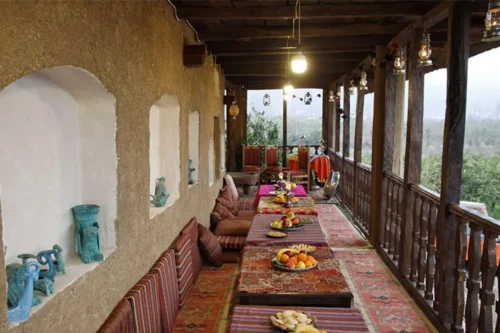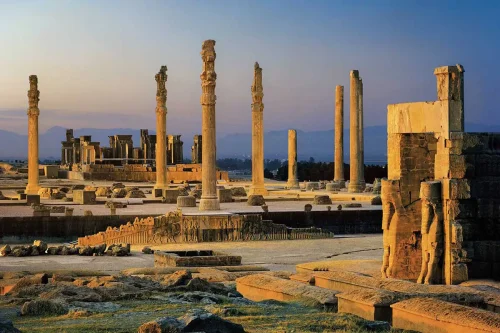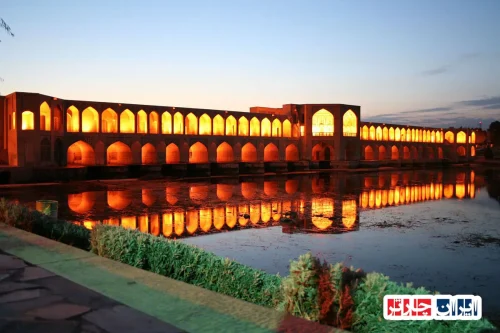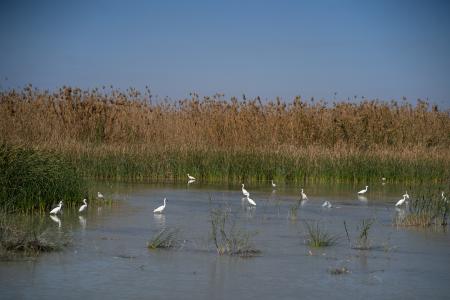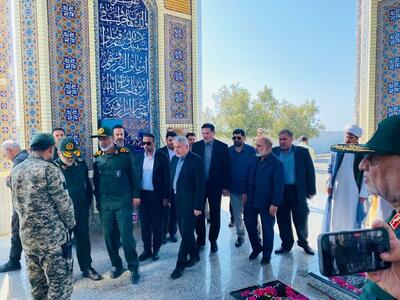News Source : https://www.irna.ir/news/85649486/%D8%AD%DA%A9%D8%A7%DB%8C%D8%AA-%D8%B3%D8%A7%D8%B2%D9%87-%D9%87%D8%A7%DB%8C%DB%8C-%DA%A9%D9%87-%D8%AF%D8%B3%D8%AA-%D8%A7%D8%B2-%D8%B3%D8%B1-%D9%BE%D9%84-%D8%AA%D8%A7%D8%B1%DB%8C%D8%AE%DB%8C-%D8%B4%D9%87%D8%B1%D8%B3%D8%AA%D8%A7%D9%86-%D8%A8%D8%B1%D9%86%D9%85%DB%8C-%D8%AF%D8%A7%D8%B1%D9%86%D8%AF
The Tale of Structures Persistently Infringing on the Historic County Bridge
Isfahan – IRNA: Rumors suggest that structures that consistently infringe upon the historic County Bridge remain steadfast in the vicinity of the historic County Bridge and the Zayandeh Rood River, threatening to tarnish and isolate the view of this ancient city bridge. According to IRNA, in recent decisions, the former structures of the Isfahan International Exhibitions Company have been handed over to the municipality for use as public spaces within the confines of the historic County Bridge, the Ashraf archaeological hill, and the Zayandeh Rood River area. Some cultural heritage experts argue that transferring these warehouses to the municipality, while located on the river bed, disrupts the public rights by obscuring the view of the historic bridge. Initially constructed temporarily, these structures should now be removed following the relocation of the exhibition to a new site, restoring the view of the bridge and structures no longer infringing on the historic County Bridge. Narges Derakhshan, an Isfahan cultural heritage activist, expressed: “For years, the historic County Bridge has been obstructed and obscured by incoherent exhibition structures, losing its prominence and appeal among citizens and tourists.” She added: “This bridge, a symbol of Isfahan’s urban identity from pre-Islamic times, is now in the hands of those working indiscreetly. The conversion of former exhibition halls within the bridge’s vicinity is regrettable and not supported by cultural heritage experts.” The spokesperson for the Isfahan province’s Cultural Heritage, Tourism, and Handicrafts Department stated that the structures were temporarily erected for the exhibition and have served as a COVID-19 vaccination center since the transfer of the exhibition to Roshandasht, Isfahan. Sharam Amiri, Isfahan’s Deputy Governor, said: “Our primary goal is to preserve the bridge’s vicinity and establish a museum site on the Ashraf archaeological hill. These areas, among the oldest parts of the city on the central Iranian plateau, can foster cultural tourism development.” The County Bridge, known as the Jey Bridge, stands as the oldest bridge over the Zayandeh Rood River, having been restored during the Sassanid, Deylamid, and Seljuk periods. The Ashraf archaeological hill, a key element in the historic city of Isfahan dating back to the Sassanian and Parthian periods, predates Islam.
The Tale of Structures That Won’t Leave the Historic ‘Shahrestan’ Bridge Alone
The structures located within the vicinity of the historic ‘Shahrestan’ bridge in Isfahan, the oldest bridge of the city, pose serious issues in preserving its natural landscape and environment. Originally erected temporarily for the Isfahan International Exhibitions, these structures have become a major challenge for the cultural and historical perspective of the bridge following the relocation of the exhibition.
Impact of Incongruent Structures on the Landscape of the Historic ‘Shahrestan’ Bridge
Incongruent structures within the vicinity of the historic ‘Shahrestan’ bridge have damaged the natural beauty and aesthetic of this bridge. Over time, these structures have been accepted as part of the surroundings of the bridge, affecting its historical authenticity and limiting access for tourists and residents.
Transfer of Exhibition Structures to the Municipality: Public Rights at Risk
The transfer of exhibition buildings to the municipality without considering environmental and historical impacts is deemed a violation of public rights. Heritage experts believe that this action not only deteriorates the view of the historic bridge but also puts historical and cultural values at risk.
Proposed Solutions for Preserving the Shahrestan Bridge’s Vicinity
Comprehensive actions and mutual cooperation between the municipality and cultural heritage bodies are needed to preserve the vicinity of the historic ‘Shahrestan’ bridge. Suggestions such as relocating existing structures, creating protected areas, and promoting cultural tourism could better protect this ancient monument.
The Role of Cultural Heritage Experts in Protecting Historic Bridges
Cultural heritage experts play a key role in the protection and maintenance of historic bridges. Their insights and recommendations related to changing the usage of structures can ensure the preservation of ‘Shahrestan’ bridge’s historical values and prevent further damage.
Negative Impacts of New Structures on Tourism in Isfahan
New structures around the historic ‘Shahrestan’ bridge not only mar its landscape but can also negatively impact the city’s tourism industry. The reduction in the historical beauty of the bridge results in decreased tourist visits, leading to a less thriving tourism industry in Isfahan.
The Importance of the Bridge’s Vicinity and Landscape in Isfahan’s Urban Identity
The historic ‘Shahrestan’ bridge is a symbol of Isfahan’s cultural and historical identity. Preserving its vicinity and landscape not only ensures historical values are maintained but also transfers the urban identity to future generations, creating a deep connection between past and present.
Suggestions for Improving the Exhibition Structures in the Bridge’s Vicinity
To improve the state of the exhibition structures around the historic ‘Shahrestan’ bridge, suggestions like revising and improving the design of structures, using eco-friendly materials compatible with the city’s history, and creating open spaces for leisure and tourism can be effective.
Future Actions for Preservation of the Historic ‘Shahrestan’ Bridge
In the future, actions like drafting protective maps, increasing monitoring of existing structures, and close cooperation with local and international bodies can aid in preserving the historic ‘Shahrestan’ bridge. These actions should be systematic and long-term to prevent further destruction.
Frequently Asked Questions
- Why were the former Isfahan International Exhibition structures handed over to the municipality?
- The former Isfahan International Exhibition structures were transferred to the municipality to be used for public interests around the historic Shahrestan Bridge, the ancient Ashraf Hill, and the Zayandeh River area.
- What are the municipality’s objectives in transferring the former exhibition structures?
- The main objective of the municipality in handing over the structures is to use them for public welfare and to free the Shahrestan bridge’s surroundings from obstructive structures.
- What are cultural heritage experts worried about regarding the transfer of these structures?
- Cultural heritage experts are concerned that transferring the structures to the municipality, situated within the riverbed of Zayandeh and marring the Shahrestan Bridge’s view, violates public rights.
- What impact do these structures have on the Shahrestan Bridge’s view?
- The structures are positioned in such a way that they mar and obscure the view of the Shahrestan Bridge, resulting in reduced visits from residents and tourists alike.
- What historical features does the Shahrestan bridge have?
- The Shahrestan bridge, also known as the Ji Bridge, is Isfahan’s oldest historic bridge over the Zayandeh River, restored during the Sassanian, Dailamite, and Seljuk periods.
- What historical role does the ancient Ashraf Hill have in Isfahan’s history?
- The ancient Ashraf Hill is one of the oldest centres for the formation of the historic city of Isfahan, dating back to the Sassanian and Parthian periods before Islam.
- What are Isfahan Province’s plans for preserving the historic bridge?
- The government of Isfahan province aims to preserve the historic bridge’s vicinity and create a museum site on the ancient Ashraf Hill, turning one of the city’s oldest areas into a suitable bedrock for cultural tourism development.
- Has the Cultural Heritage Organization expressed its views on changing the use of these structures?
- The spokesperson of the Isfahan province’s Cultural Heritage, Tourism, and Handicrafts Department has stated that the structures were temporarily built for the exhibition and had no specific use after the exhibition’s relocation and conversion into a vaccination site during the Corona period.
- What is the government’s policy regarding the use of temporary structures after the completion of the international exhibition?
- The province government’s decision was to hand over the temporary exhibition structures to the municipality for public interest use without disregarding the historic bridge’s view.
- How were the structures used post-exhibition?
- After the exhibition ended, the structures were converted into a vaccination site during the Corona period and have now been handed over to the municipality for public welfare use.
- During which historical periods was the Ji Bridge, Isfahan’s oldest historic bridge, restored?
- The Ji Bridge, the oldest historic bridge in Isfahan, was restored during the Sassanian, Dailamite, and Seljuk periods.
- To which historical eras does the ancient Ashraf Hill belong?
- The ancient Ashraf Hill belongs to the Sassanian and Parthian eras, dating back to before Islam.
- Why has the historic bridge’s view diminished?
- The historic bridge’s view has been marred due to the incongruent exhibition structures in its proximity, leading to less attraction from residents and tourists.
- What impact did the vaccination site have on the structures?
- The vaccination site took over the structures’ primary function, yet they remain in place without a specific use.
- How do municipalities plan to advance cultural tourism development in these areas?
- Municipalities plan to preserve the historic bridge’s vicinity and create a museum site on the ancient Ashraf Hill to turn these areas into suitable grounds for cultural tourism development.
- What did Narges Derakhshan comment about the historic bridge’s status?
- Narges Derakhshan, an Isfahan cultural heritage activist, stated that the historic Shahrestan bridge is obstructed and its vicinity and view affected due to incongruent exhibition structures.
- Has the Cultural Heritage, Tourism, and Handicrafts Department of Isfahan province expressed its opinion on the structures?
- The department’s spokesperson has stated that the structures were temporarily erected for the exhibition and had no specific use after the exhibition was moved and became a vaccination site.
- Why is the historic Shahrestan bridge less frequented by citizens and tourists?
- The Shahrestan bridge is less frequented due to incongruent exhibition structures that mar its view, thus losing its utility and dynamism.


